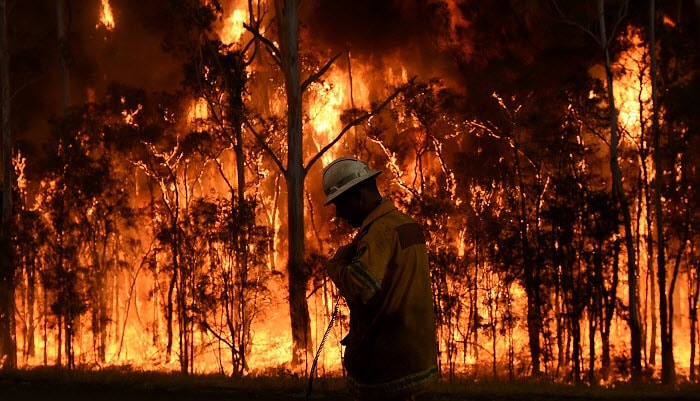Crafting Your Home's Safety and security: A Detailed Bushfire Management Plan Overview
Crafting Your Home's Safety and security: A Detailed Bushfire Management Plan Overview
Blog Article
The Importance of Bushfire Management in Fire Defense
In the world of fire security, the relevance of efficient bushfire management can not be understated. As areas globally come to grips with enhancing instances of wildfires, the proactive strategy to stop and reducing these natural disasters via calculated bushfire administration techniques has actually become a vital aspect. Beyond the prompt risk to human life and home, the interplay in between bushfire administration and ecological conservation, community participation, and climate change presents complex obstacles that demand thorough options.
Significance of Proactive Bushfire Avoidance
Positive bushfire avoidance strategies are vital in minimizing the ruining impacts of wildfires on communities and areas. One key element of positive bushfire avoidance is fuel monitoring.
Informing the public on fire safety and security techniques and advertising area awareness regarding the significance of bushfire prevention are crucial parts of positive methods. Inevitably, proactive bushfire avoidance plays a significant duty in protecting areas and communities from the destructive effects of wildfires.
Role of Neighborhood Interaction in Fire Protection
Involving the community in fire defense efforts is important to enhancing the efficiency of aggressive bushfire prevention approaches. Community involvement plays an important duty in fostering a cumulative understanding of the risks presented by bushfires and the significance of readiness measures. By entailing local homeowners, authorities can disseminate essential info ablaze security techniques, emptying procedures, and very early warning systems, equipping people to take positive actions to protect their lives and buildings.
By promoting a culture of readiness and cooperation, areas can strengthen their capacity to react successfully to bushfire emergencies, minimizing the influence on lives and buildings. Eventually, community involvement is a foundation of extensive fire protection approaches, highlighting the importance of cumulative activity in protecting at risk areas from the hazard of bushfires.
Relevance of Wildlife Conservation in Bushfire Management
Conservation of wildlife plays a critical function in reliable bushfire administration strategies, making certain the security of diverse ecosystems and biodiversity in fire-prone areas. Wildlife conservation is crucial as it contributes to the general resilience of ecological communities, helping in their ability to stand up to and recover from the effect of bushfires. By preserving habitats and securing various varieties, the natural balance within these ecosystems is preserved, which is essential for their long-lasting health and wellness and sustainability.
In addition, wildlife preservation likewise aids in reducing the risk and intensity of bushfires. Healthy and balanced ecological communities with well-preserved wildlife populations can serve as all-natural firebreaks, reducing the spread of fires and restricting their devastating potential (BMP). Particular pet varieties, like delving animals or birds that spread seeds, play distinct functions in helping or stopping fires in the post-fire regrowth of environments
Including wild animals conservation right into bushfire monitoring approaches is not just crucial for safeguarding biodiversity but also for promoting the overall health and durability of environments despite raising fire threats.
Advantages of Strategic Gas Reduction Programs
Strategically implementing fuel reduction programs is essential in mitigating the threat and effect of bushfires in fire-prone regions. These programs involve regulated burning, mechanical cleaning, and other methods to lower the quantity of flammable vegetation available to you can look here sustain wildfires. By tactically decreasing fuel tons in key locations, such as close to domestic areas or important infrastructure, the strength and spread of bushfires can be dramatically reduced.
One of the main benefits of gas reduction programs is the enhancement of general fire strength in an ecological community. By creating critical fuel breaks and minimizing the connection of greenery, these programs aid to interrupt the course of a bushfire, making it easier for firemens to extinguish the blaze and have. Additionally, gas decrease programs can protect biodiversity by stopping exceedingly intense fires that can ravage environments and threaten wildlife populaces.
In addition, these programs can also secure human lives and residential property by reducing the danger of tragic fires that pose a considerable threat to neighborhoods. Inevitably, strategic fuel reduction programs play a crucial role in positive bushfire management and fostering a much safer setting for both individuals and nature.
Influence of Climate Change on Bushfire Risk

Greater temperature levels result in drier plant life, making it much more susceptible to ignition. Decreased rainfall in specific areas extends drought problems, additionally increasing the flammability of the landscape. Furthermore, the transforming environment has actually altered wind patterns and weather, bring about more erratic fire behavior and fast fire spread.
As the environment continues to alter, the frequency and intensity of bushfires check these guys out are anticipated to rise, necessitating a adaptive and proactive strategy to bushfire management. Approaches should progress to represent the altering danger landscape, including environment estimates and taking into consideration long-term resilience in fire management preparation. Addressing visit this website the impact of climate change on bushfire risk is essential in establishing efficient techniques to safeguard lives, property, and the setting.
Verdict
To conclude, aggressive bushfire avoidance, community involvement, wildlife preservation, strategic gas decrease programs, and consideration of climate adjustment are critical parts in efficient fire security. By executing these strategies, we can much better handle bushfire dangers and protect both human lives and the environment. BAL Assessment. It is vital that stakeholders work together to prioritize these actions to decrease the damaging influence of bushfires on areas and ecological communities

As the environment continues to change, the regularity and strength of bushfires are expected to rise, demanding a aggressive and adaptive strategy to bushfire administration.In final thought, proactive bushfire prevention, area involvement, wild animals conservation, calculated fuel decrease programs, and factor to consider of environment change are important components in reliable fire defense.
Report this page